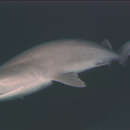en
names in breadcrumbs


Cow sharks are a shark family, the Hexanchidae, characterized by an additional pair or pairs of gill slits. Its 37 species are placed within the 10 genera: Gladioserratus, Heptranchias, Hexanchus, Notidanodon, Notorynchus, Pachyhexanchus, Paraheptranchias, Pseudonotidanus, Welcommia, and Weltonia.[2]
Cow sharks are considered the most primitive of all the sharks, as their skeletons resemble those of ancient extinct forms, with few modern adaptations. Their excretory and digestive systems are also unspecialized, suggesting they may resemble those of primitive shark ancestors. A possible hexanchid tooth is known from the Permian of Japan, making the family a possible extant survivor of the Permian-Triassic extinction.[3]
Their most distinctive feature, however, is the presence of a sixth, and, in two genera, a seventh, gill slit, in contrast to the five found in all other sharks.[4] The first pair are not connected across the throat.[5] They range from 1.4 to 5.5 m (4.6 to 18.0 ft) in adult body length.
These cylindrical sharks have a ventral mouth with compressed. comb-like teeth in the lower jaw and smaller, pointed teeth in the upper jaw. They have a short, angular and spinless dorsal fin. The pelvic fins are smaller than the angular pectoral fins. The causal fin has a notch towards the end.[5]
Cow sharks are ovoviviparous, with the mother retaining the egg cases in her body until they hatch. They feed on relatively large fish of all kinds, including other sharks, as well as on crustaceans and carrion.[6]
The only fossil records of the cow shark consist of mainly only isolated teeth. Although skeletal remains for this species have been found from the Jurassic time period, these have been very rare and have only been found in the "Late Jurassic lithographic limestones of South Germany, Nusplingen, Solnhofen, and late Cretaceous calcareous sediments of Lebanon." Due to these sparse records some scientists conclude that the cow shark is now a more "diverse and numerous species".[7]

The 37 species of cow shark (four of which are extant), in 10 genera, are:[5][1]
Cow sharks are a shark family, the Hexanchidae, characterized by an additional pair or pairs of gill slits. Its 37 species are placed within the 10 genera: Gladioserratus, Heptranchias, Hexanchus, Notidanodon, Notorynchus, Pachyhexanchus, Paraheptranchias, Pseudonotidanus, Welcommia, and Weltonia.